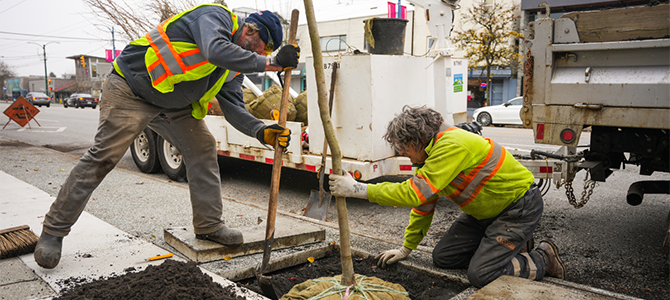
 Vancouver Park Board approves updated Urban Forestry Strategy
Vancouver Park Board approves updated Urban Forestry Strategy
At the Vancouver Park Board meeting last night, Commissioners approved a new updated strategy and action plan for managing, protecting and growing Vancouver’s urban forest canopy while advancing reconciliation, climate adaptation and equitable access to trees.
“Trees are Vancouver’s hardest-working infrastructure,” said Vancouver Park Board Chair, Laura Christensen. “They help keep residents safe during extreme weather, provide shade and cooling during heat, and slow the flow of rainfall into storm drains to prevent flooding. They also clean our air, support wildlife and make Vancouver more livable. This strategy charts a path forward that helps ensure all residents can benefit from one of our city’s most important assets.”
The updated Urban Forest Strategy PDF file (55 MB) emphasizes a fiscally responsible approach that will help increase the urban canopy by five per cent over the next 25 years to meet Vancouver’s goal of 30% canopy coverage by 2050. Vancouver’s current Urban Forest Strategy guides the care and planting of trees on public and private land and was last updated in 2018.
“The new strategy will allow us to grow our canopy within existing budgets by being more thoughtful and more precise with how we plant trees,” said Amit Gandha, Director of Parks. “It will also give us comprehensive data on all of our existing trees so we can keep them healthier for longer.”
The new Urban Forest Strategy focuses on three key areas:
- Strategic planning to maintain and grow the urban canopy on public and private land with an eye to maximizing the return on investment on trees planted and the money spent to plant them. Three short-term priority actions have been identified to fast-track this goal. Highlights include investing in data to help us better maintain the trees we have, and evaluation of land uses across the city and their capacity to support canopy by adding the ‘right tree’ in the ‘right place’ at the ‘right pace’. Staff will also pursue donations like the three-year seedling contribution recently secured from Western Forest Products to help restore Stanley Park and a tree sale to encourage residents to plant climate-adapted trees on private property.
- Improving equitable access to tree canopy by identifying city blocks with both a high concentration of vulnerable populations and significant gaps in canopy coverage to prioritize planting efforts. Vulnerable populations in low-canopy areas face a higher risk of heat-related deaths. Currently, Strathcona, Sunset and Downtown have the lowest canopy cover and Strathcona is the only neighbourhood with less than 10% of canopy cover due to historical industrial land-uses.
- Advancing reconciliation by continuing to strengthen relationships with the xʷməθkʷəy̓əm (Musqueam), Sḵwx̱wú7mesh (Squamish), and səlilwətaɬ (Tsleil-Waututh) Nations through ongoing knowledge sharing and by supporting cultural events. Future initiatives will build on partner efforts through the hemlock looper response in Stanley Park including ceremonial planting and cultural use of wood.
Since 2013, Vancouver’s tree canopy has grown by four percent to 25% city-wide. The strategy sets an ambitious target of achieving 30% canopy coverage by 2050 in Metro Vancouver’s most densely populated and developed city. The strategy will go to City Council for final approval on May 21.